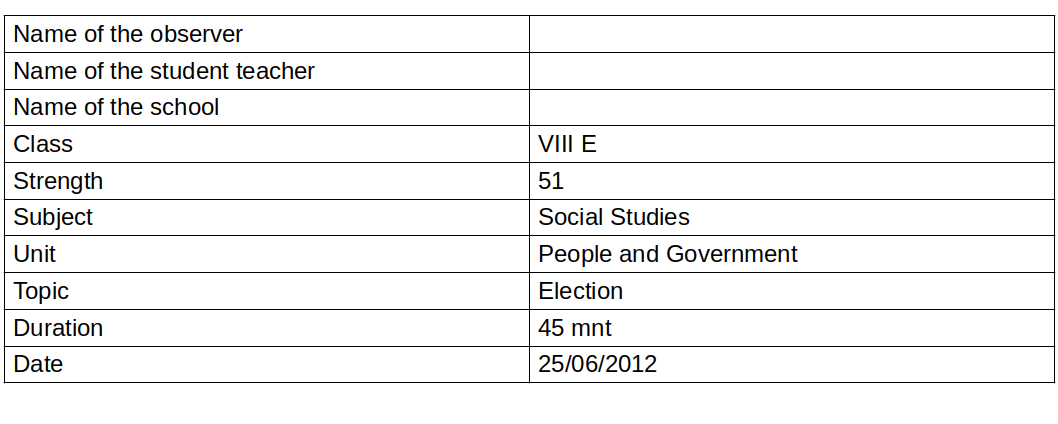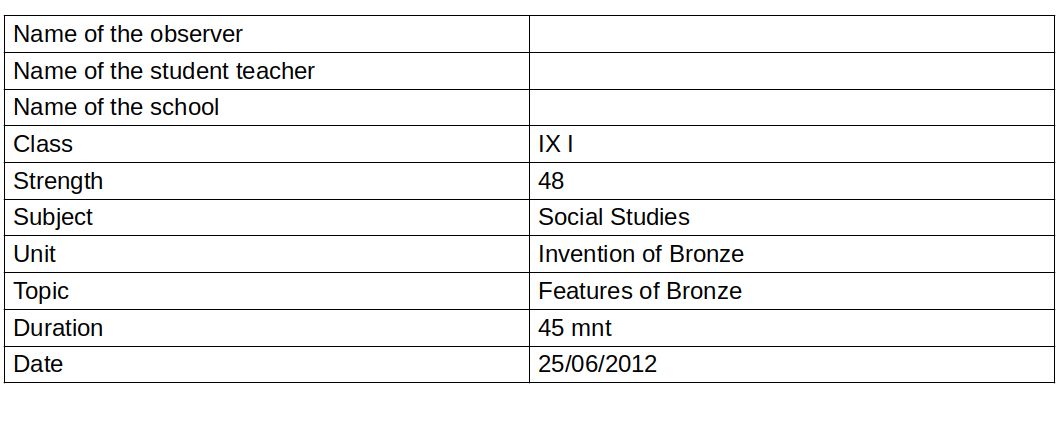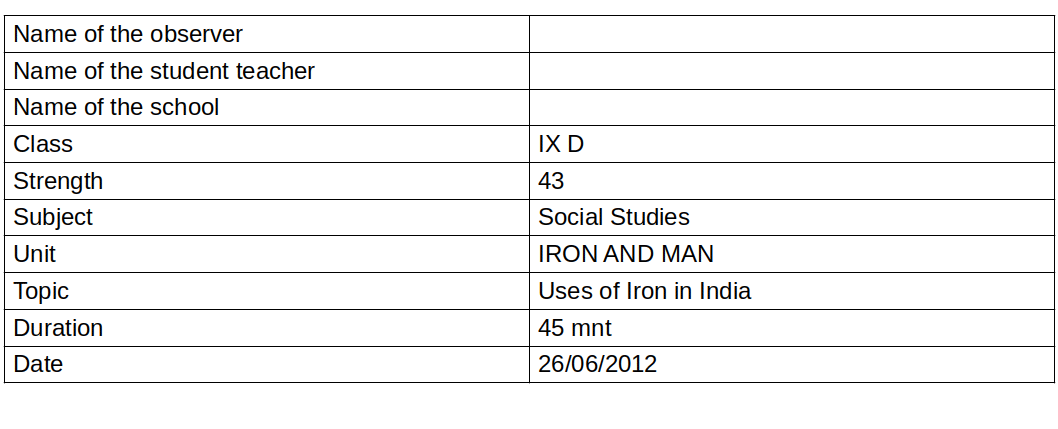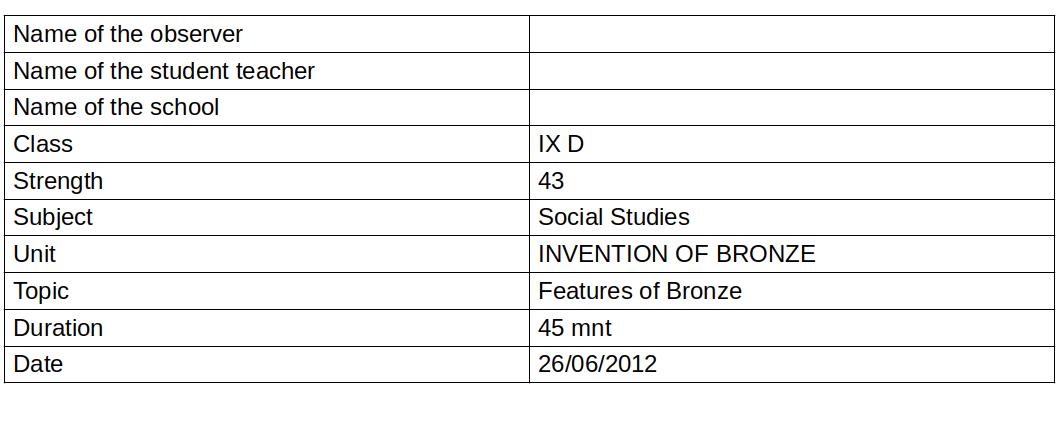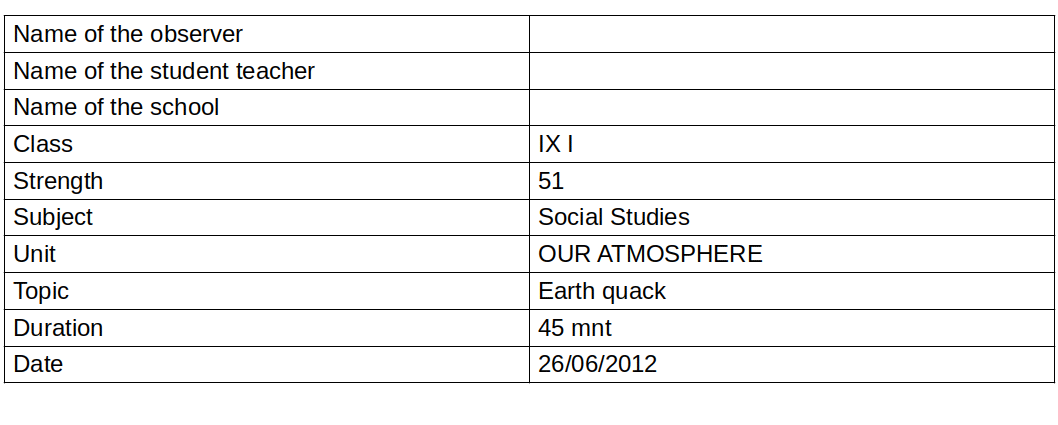FIELD BASED EXPERIENCE RELATED TO PRACTICE TEACHING OF B.Ed TRAINEES.
Chapter.1
INTRODUCTION
Education is the principal tool of human growth, essential for transforming the unlettered child in to socio-economic condition of the nation. The task of education is to lead people out of darkness in to light. The quality of a particular kind of education is largely depended on the quality of teachers. Teachers are the role models for students and they contribute to shape the character and destinies of millions of our children. The teacher is the yardstick that measures the achievements and aspiration of a nation. The worth and potentialities of a country evaluated in and through the work to the teacher.
EDUCATION: MEANING AND DEFINITION
DEFINITION:-
The word education literally means to “bring forth” which indicates that the true task of this process is drawing forth from the mind its innate potential for understanding. The Oxford dictionary defines “education as systematic instruction”. In its technical sense education is the process by which society deliberately transmits its accumulated knowledge, skills and values from one generation to another.
MEANING:-
According to Gandhiji,”by education I mean an all round drawing out of the best in child and man, body, mind and spirit.’
Chapter.2
MEANING OF TEACHING.
According to the eminent educationist Adams, “teaching is a bi-polar process its one pole is teacher and another is the pupil. Teaching is a social philosophy; values and culture of every nation leave their impression.
The teacher brings desired changes in the behavior of the pupils by influence of his own personality and pupil is influenced by following him. In this way, this process, the efforts of the teacher are called teaching and the task performed by the pupil is termed as learning.
PRACTICE TEACHING
Practice teaching is compulsory item of all. Teacher education programs and it comes usually at the phase in the sequence of the professional preparation teachers where attempt is made to bring theory and practice together. Practice teaching provides best situation for assessing the mastery of the knowledge and skills required for an effective teaching. It aims at planning the trainees in a position where they learn to use their theoretical knowledge effectively and confident manner.
From the beginning of the professional preparation of teaching practice teaching has been an essential part of teacher education curriculum, such it is during this period that student teacher are expected to be actively engaged in extensive direct experience in a school under the guidance of the staff teacher of the college for co-operating school to learn the dimensions of the profession of teaching and to acquire competence required for entering the teaching profession.
OBJECTIVES OF PRACTICE TEACHING
- To aware of different evaluation devices and tools and their application in knowing the growth of the student.
- To assume gradually and finally the responsibility of teaching.
- To budget the syllabus according to the amount of time and resources available.
- To develop satisfactory relationship with students.
- To practice skill and develop competence in relating learning materials the techniques of teaching and instructional materials the needs of community.
- To be aware of different evaluation devices and tool and their application to know the growth of student.
- To identify exceptional learners and assist them.
- To understand the process of curriculum development, teacher develop skill in planning various types of lessons using varieties of methods and strategies.
- To develop professional attitudes.
- To use available human and material resources effectively.
- To provide an opportunity for applying theory in practical situation.
CHARETERISTICS OF GOOD TEACHING.
The following are the characteristics of good teaching
- Good teaching must have describable information.
- Good teaching must motivate for self learning.
- Good teaching must have efficient planning.
- Good teaching must be selective and useful.
- Good teaching must provide opportunities for activity.
- Good teaching must be sympathetic.
- Good teaching must be co-operative.
- Good teaching is organization of learning.
- Good teaching must be democratic.
- Good teaching must be progressive.
- Good teaching must be lead to emotional stability.
- Good teaching must help the child to adjust himself to his environment.
- Good teaching is a means of pre creation.
- Good teaching is both diagnostic and remedial.
PRINCIPLES OF TEACHING
The principles are necessary to control the behavior of the teacher; the following two types of teaching principles are emphasized.
- General principles of teaching.
- Psychological principles of teaching.
GENERAL PRINCIPLES OF TEACHING
- Principle of motivation. The motivation is that method which creates pupils interest in the content.
- Principle of interest. It means to create interest of the pupils in the subject matter in order to make the teaching useful and effective.
- Principle of learning by doing
- Principle of linking with life
- Principles of selection of contents
- Principle of recognizing individual differences
- Principle of definite aim
- Principle of revision
- Principle of creation and recreation
- Principle of division
- Principle of democratic dealing
- Principle of planning
PSYCHOLOGICAL PRINCIPLES OF LEARNING
The psychological principles of teaching affect the teaching process directly and indirectly. The psychological principles are,
- Principle of motivation and interest
- Principle of imparting training
- Principle of encouraging creativity and self expression
- Principle of reinforcement
- Principle of remedial teaching
- Principle of sympathy and co-operation
- Principle of repetition and exercise
- Principle of recreation
SIGNIFICANCE OF SOCIAL SCIENCE EDUCATION
The content of the social science curriculum and the methods and strategies to be adopted for its transaction will naturally depend upon the purpose for which the subject is being taught to pupils who form the future generation. In other words what and how of learning of a subject are determined by the why of it. The broad goal as well as the specific objectives of learning social science is the basis for considering it an essential part of the school curriculum. This is the reason why every teacher of social science has to acquire a deep insight in the aims and objectives to be realized by its learning.
ESSENTIAL QUALITIES OF A SOCIAL SCIENCE TEACHER
- Scholarship
- Professional training
- Personality
- Teaching skill
- Human relations
SPECIAL QUALITIES OF A SOCIAL SCIENCE TEACHER
- Social moderator and engineer
- Objectivity
- Deep knowledge of the subject
- Application of field study theory
- A well formed teacher
- Widely travelled person
- A good communicator
- Skill in the use of technological aids
- An interpreter of various experiences
Chapter.3
METHODOLOGY
PLANNING OF THE PROJECT
OBJECTIVES OF THE STUDY
- To enable the observer in guiding the student teacher and provide the recognition of specific experience and suggestions which can aid the student teacher continuously and expand his competence as a teacher.
- To identify some skills, competence and quantities are considered the base of effective teaching.
- To aid the student teacher to become aware of which competence have been achieved and which are skill be achieved.
NEED AND SIGNIFICANCE OF THE STUDY
METHODOLOGY OF THE STUDY
SAMPLE OF THE STUDY
METHOD USED
TOOLS USED
SKILLS IN SOCIAL SCIENCE
The aim of this project is to observe a minimum of five practice teaching classes of student teachers and to critically evaluate it
A field based experience on practice teaching of B.Ed trainees’ social studies team will provide a good understanding of various aspects of teaching in high school level. Hence monitoring and evaluation should be made as an integral part of the M.Ed course to know the strength ,weakness and outcome of teacher education program with connective measures for optimizing the effectiveness of this program.
Methodology of the study deals with precise description of the sample taken for the study, tool etc…
Sample of study is five B.Ed trainees whose optional subject was social studies.
Method used for present study is observation
Tool used for observation and evaluation was “Observation Schedule” in social studies
Teaching skill is a related overt behavior of teachers which are observable, definable, measurable, and demonstrable, through practice. Criteria are used for observation of the classes taken by social studies B.Ed trainees are given below.
- Lesson plan and preparation
- Motivating the pupil
- Systematic presentation.
- Execution of the class.
- Reinforcement.
- Proper use of teaching aids.
- Proper communication skill.
- Suitable teaching method being used.
- Distribution of the questions throughout the class.
- Mastery over subject.
- Considered backward students.
- Peer group evaluation.
- Fearless atmosphere inside the classroom.
- Mastery over the subject.
- Opportunity for using students’ observation book.
- Lessons being developed through students’ response.
- Proper class management.
- Black board.
- Proper budgeting the time.
- Teacher’s personality.
- Closure.
Chapter.4
EVALUATION
The present tendency is to use the term evaluation is place the term examination. Evaluation is a process by means of which changes in behavior of children are studied and guided towards goals sought by a school. Evaluation is the process of assigning value something. This possible only on the basis of pre determined goals. Education based on pre determined objectives is called objective based evaluation.
FUNCTIONS OF EVALUATION
- To make provisions for the growth of individual pupil
- Evaluation enhances the quality of teaching
- Evaluation helps in clarifying the objectives
- Evaluation motivates learners
- Guidance can be given on the basis of evaluation
- Evaluation helps in adjusting the relative position of students within a group
- Evaluation can help in bringing changes in the curriculum
- It locates area where remedial measures required
- To diagnose the weakness and strength of pupils
TYPES OF EVALUATION
FORMATIVE EVALUATION
Described as evaluation used for the ongoing improvement of process. It is designated to enhance the effectiveness of teaching learning process. It aims to discovering the strengths and weakness of students in various subjects so that remedial steps may be taken by the teacher to remove their deficiencies.
SUMMATIVE EVALUATION
Level of evaluation is described as evaluation of finished products which has been defined by the use of formative evaluation. It is concerned with making of final judgment about the progress of students. It is used primarily for assigning course, grades or for certifying student mastery of indented learning outcomes at the end of a course program.
RECENT TRENDS IN EVALUATION
The concept of evaluation in modern times has entirely been changed. Introduction of grading system of examination, internal assessments, semester system, question banks, computer based testing etc. are the characteristics of modern evaluation.
Chapter.5
OBSERVATION AND EVALUATION REPORT .1
The topic under discussion was Election. Learning objectives were clearly stated. Issue, theme, sub issues were pointed in the teaching manual. Introductory activities are closely linked with the day to day situation of the students. Process resources were clearly mentioned.
EXECUTION
- LESSON PLAN AND PREPARATION
- MOTIVATION.
- SYSTEMATIC PRESENTATION.
- EXECUTION OF THE CLASS.
- REINFORCEMENT.
- PROPER USE OF TEACHING AIDS.
- PROPER COMMUNICATION SKILL.
- SUITABLE TEACHING METHODS BEING USED.
- DISTRIBUTION OF THE QUESTIONS THROUGH OUT THE CLASS.
- MASTERY OVER SUBJECT.
- CONSIDERED TO BACKWARD STUDENTS.
- PEER GROUP EVALUATION.
- FEARLESS ATMOSPHERE INSIDE THE CLASSROOM.
- OPPORTUNITY FOR USING STUDENTS OBSERVATION BOOK.
- LESSONS BEING DEVELOPED THROUGH STUDENTS RESPONSE.
- PROPER CLASS MANAGEMENT.
- BLACK BOARD.
- SPOT DIAGNOSIS OF LEARNING DIFFICULTY AND SUGGEST REMARKS.
- PROPER BUDGETING THE TIME.
- TEACHERS PERSONALITY.
- CLOSURE.
The lesson plan was good and relevant to attain the objective. Lesson plan was appropriate to the topic. Learning aids were not mentioned in the manual.
The teacher could not provide interesting motivational techniques to the students. So the students are not actively participated in the motivational activity. Thus the teacher failed in creating a motivating situation in the classroom.
Teacher has adequate knowledge about the topic. She could explain the topic in easily and simply. She presented the topic in a systematic manner and covered all the essential points.
Teacher helped to construct knowledge with the active participation of all students. Activity was suitable to the nature of the child.
Student teacher gave proper verbal and non verbal reinforcement at appropriate places and time.
Teacher used teaching aids effectively. Charts were used at the right time. They were relevant in explaining the content.
Teacher was good in her communication skill. Her sound was audible to all. It was clear, simple and continuous.
The teacher used lecture method and debate for the presentation of the content.
The questions were simple and precise. It was relevant to the content and had clarity. But the distribution of questions was not good.
Teacher had enough knowledge and competency in the subject. She showed mastery over the subject and topic.
Teacher did not considered backward students.
Teacher conducted good peer group evaluation.
There was a democratic atmosphere prevailed in the class room.
Teacher observed the students activities properly.
The teacher developed the lessons through responses of the students. She asked some simple questions.
The teacher effectively managed the class. Teacher pupil interaction was friendly.
The teacher rarely used the black board. It is an effective aid for a teacher. Hand writing was legible and neat. Teacher did not use colour chalks when needed. The teacher could write important points on black board.
Teacher’s ability to diagnosis learning difficulty was very poor and she did not made any remarks about it.
Time should be utilized properly.
Teacher was active and energetic throughout the class. She was dedicated and punctual to the profession.
Teacher summarized the lesson and gave review of the lesson briefly and properly and also given follow up activities. Follow up activity was on the basis of knowledge constructed.
Overall performance of the student teacher was average. The teacher must take necessary steps to improve the teaching especially in managing time.
The given below are the suggestions to improve the performance of the teacher.
- The lesson plan should mention learning aids.
- Teacher must practice questioning skills.
- Teacher should try to involve more learning activity in teaching.
- Should try to motivate pupil.
- Should try to practice continuity in explaining.
- Teacher should consider multilevel grade students.
- Should try to add more teaching aids.
- Should try to link between present and past.
By giving attention to these suggestions, she can become a good and effective teacher.
OBSERVATION AND EVALUATION REPORT -2
The topic under discussion was the Features of bronze and was taken in class IX.I. Teaching manual was submitted to the observer before the beginning of the class.
EXECUTION
- LESSON PLAN AND PREPARATION.
- MOTIVATING THE PUPIL.
- SYSTEMATIC PRESENTATION.
- EXECUTION OF THE CLASS.
- REINFORCEMENT.
- PROPER USE OF TEACHING AIDS.
- PROPER COMMUNICATION SKILL.
- SUITABLE TEACHING METHOD BEING USED.
- DISTRIBUTION OF QUESTIONS THROUGHOUT THE CLASS.
- MASTERY OVER SUBJECT.
- CONSIDEREDTO BACKWARD STUDENTS.
- PEER GROUP EVALUATION.
- FEARLESS ATMOSPHERE INSIDE THE CLASS ROOM.
- OPPORTUNITY FOR USING STUDENTS OBSERVATION BOOK.
- LESSONS BEING DEVELOPED THROUGH STUDENTS RESPONSE.
- PROPER CLASS MANAGEMENT.
- BLACK BOARD.
- SPOT DIAGNOSIS OF LEARNING DIFFICULTY AND SUGGEST REMARKS.
- PROPER BUDJETING THE TIME.
- TEACHER’S PERSONALITY.
- CLOSURE.
The lesson plan was well prepared and had a clear outline about the topic. Lesson plan was adequate and relevant to attain the objective.
The teacher entered the class by greeting the pupil. First teacher could not secure attention of the pupil but after starting the lesson teacher could establish rapport with pupil. Teacher entered to the lesson by asking motivating questions. Thus the students really became motivated. She asked thought provoking questions at the time of introduction.
Teacher has adequate knowledge about the topic. Learning experience was properly presented. She presented the content in logical and sequential order. Teacher had clarity in explaining the topic and covered all the essential points. Teacher also used discussion method while presenting the content.
Activity given to the teacher was suitable to attain the specific skills and the nature of the child. Teacher could integrate all the relevant points from each group. She acted as a facilitator throughout the class.
The teacher used verbal positive reinforcement throughout the class.
The student teacher used charts and pictures effectively. They were neat and attractive. She did not use pointer while using charts.
The teacher had a good communication skill. The voice of the teacher was clear and loud. Teacher shows changes in the speaking pattern. Teacher could make rapport with students. Teacher’s expressions were excellent.
The teacher used lecture method for the presentation of the content and the method was apt to the topic.
Questions were simple, appropriate to the content taught. Questions were thought provoking. Teacher could evenly distribute the questions. Knowledge of current affairs was average.
Subject competency was poor, not relevant to the situation. Facts explained were relevant and knowledge of current affairs was very poor.
Teacher avoided backward students completely.
Teacher failed in evaluating peer groups.
Teacher have fearless atmosphere inside the class room.
Supervision of the students’ activities done by the teacher was average. The mistakes of the students were corrected.
The teacher developed the lesson through the responses of the students. Learning experiences through activities was given
The teacher effectively managed the class. Interaction with the students was adequate. Teacher managed the time properly.
Teacher used black board as an effective aid. Handwriting was legible and clear but did not use colour chalks where ever needed. Writing arrangement was good. Pupil got summary of the topic from the board.
Teacher could find learning difficulty and suggested some solutions for learning difficulty.
Teacher managed the time properly.
Teacher’s appearance was good and the movements were appropriate in the class room. Teacher was ready to clarify the doubts of the students pleasantly. The teacher was dedicated and punctual.
Teacher gave review of the lesson briefly and summarized the lesson properly and also gave follow up activities. Follow up activities were used in the class room.
Overall performance of the student teacher was average. Student Teacher’s preparation of lesson plan was good, besides she could motivate the pupils. Teacher had very good communication skills. Teacher must take necessary steps to improve the teaching process especially in managing time.
Some suggestions are given below.
- Specific objectives should be added in the lesson plan.
- Proper instruction should be given before starting learning activities.
- Should try to cover all the points while explaining.
- While using charts and pictures should use a pointer.
- Teacher should acquire subject competency and mastery of subject.
- Should conduct peer group evaluation.
In spite of some minor defects, the class was interesting and effective.
OBSERVATION AND EVALUATION REPORT -3
The topic under discussion was Iron and Man and was taken in class IX.D. Learning objectives were clearly stated in the lesson plan.
EXECUTION
- LESSON PLAN AND PREPERATION
- MOTIVATION.
- SYSTEMATIC PRESENTATION.
- EXECUTION OF THE CLASS.
- REINFORCEMENT.
- PROPER USE OF TEACHING AIDS.
- PROPER COMMUNICATION SKILL.
- SUITABLE TEACHING METHOD BEING USED.
- DISTRIBUTION OF QUESTIONS THROUGH OUTTHE CLASS.
- MASTERY OVER SUBJECT.
- CONSIDERED BACK WARD STUDENTS.
- PEER GROUP EVALUATION.
- FEARLESS ATMOSPHERE INSIDE THE CLASS ROOM.
- OPPORTUNITY FOR USING STUDENTS OBSERVATION BOOK.
- LESSON BEING DEVELOPED THROUGH STUDENTS RESPONSE.
- PROPER CLASS MANAGEMENT.
- BLACK BOARD.
- SPOT DIAGNOSIS OF LEARNING DIFFICULTY AND SUGGEST REMARKS.
- PROPER BUDGETING THE TIME.
- TEACHERS PERSONALITY.
- CLOSURE.
The lesson plan was well prepared and had a clear out line about the topic. Lesson plan was adequate and relevant to achieve the objective. Learning aids were not mentioned in the manual.
The teacher accepted the greetings of the students. Teacher had anxiety in her face. There by the introduction was less motivating. A more motivating introduction can be used for introducing the concept.
The teacher presented the lesson in a systematic manner. Explanation was moderate. Teacher could not cover all the essential points.
Teacher effectively supervised the activities of the students. She provided proper instructions at the right time. Activity was not suitable to the pupil in the class. Teacher failed to consolidate all the points that are made by students.
Teacher gave proper verbal and non verbal reinforcement. Most of the reinforcement were positive.
Teacher showed pictures of different iron factories. It was a good attempt. Students really enjoyed it, and helped in understanding the topic. Teacher also used text book and chart as teaching aids and she wrote all main points in the chart.
The communication skill was good. Teacher tried her level best for effective interaction in the classroom.
Teacher used lecture method and discussion for the presentation of the content. Teacher has fair knowledge of the methods.
Questions were clear and relevant to the content.
The teacher has sufficient knowledge in the subject. Facts explained accurate. Teacher has skill in teaching. But teacher’s knowledge about current affairs was poor.
Pupil participation was good. All students actively participated in group work.
Peer group evaluation was good.
The student teacher effectively managed the class. Teacher pupil interaction was friendly.
The teacher effectively supervised the activities of the pupils. Teacher helped the students whenever necessary.
The teacher was successful in eliciting the correct response from students. Teacher does not give proper direction to the learner at the time of answering.
Class management was not effective. Students make sounds at the time of group discussion and activity work.
The teacher used black board as an effective aid. The handwriting was not legible and clear. Teacher failed in writing all the important points on the black board. Writing arrangement was bad and she did not use clour chalks in writing on board. Teacher forgot to erase board before asking questions to the pupil.
Student teacher gave attention to all the students equally.
The time management was good. Teacher could complete the class in time.
Teacher had an ideal personality and she was clean, neat and tidy. She had a pleasing appearance.
Teacher reviewed main concepts and statements. She gave follow up activities on the basis of knowledge constructed. Teacher won in creating the sense of achievement.
The performance of the student teacher was average. Student teacher performed all the teaching activities in a good manner but student teacher can include more activities in the lesson plan. Which will make the teaching process more interesting. Teacher should try to involve more teaching methods in practice teaching.
For the improvement of the teaching process, some suggestions are given below. They are,
- Teacher should add activities appropriate to the class and student.
- Teacher should try to acquire more knowledge about current affairs.
- Should try to improve class management.
- Teacher should try to develop proper use of black board.
OBSERVATION AND EVALUATION REPORT -4
The topic under discussion was uses of features of bronze and was in class IX.I.
EXECUTION
- LESSON PLAN AND PREPERATION.
- MOTIVATION.
- SYSTEMATIC PRESENTATION.
- EXECUTION OF THE CLASS.
- REINFORCEMENT.
- PROPER USE OF TEACHING AIDS.
- PROPER COMMUNICATION SKILL.
- SUITABLE TEACHING METHOD BEING USED.
- DISTRIBUTION OF QUESTIONS THROUGHOUT THE CLASS.
- MASTERY OVER SUBJECT.
- CONSIDERED BACK WARD STUDENTS.
- PEER GROUP EVALUATION.
- FEARLESS ATMOSPHERE INSIDE THE CLASS ROOM.
- OPPORTUNITY FOR USING STUDENTS OBSERVATION.
- LESSONS BEING DEVELOPED THROUGH STUDENTS RESPONSE.
- PROPER CLASS MANAGEMENT.
- BLACK BOARD.
- PROPER BUDGETING THE TIME.
- SPOT DIAGNOSIS OF LEARNING DIFFICULTY AND SUGGEST REMARKS.
- TEACHERS PERSONALITY.
- CLOSURE.
The lesson plan prepared by the teacher was moderately good. The teacher can include some more activities in the lesson.
Teacher entered to the lesson by asking motivating questions. Thus the students really become motivated. She asked questions at the time of introduction and established a well rapport with the students.
Explanation was relevant to the content and it was accurate.
The learning activities included in the lesson plan were fewer in number but it is appropriate. Teacher gives clear and concise guidelines for group activity.
Teacher gave positive reinforcement at appropriate time.
Teaching aids were relevant in explaining the content. Teacher used only charts and they were very much interesting.
Teacher communication was moderately good. The teacher has good expression and speech.
Teacher used lecture method and discussion for the presentation of the content. Teacher has fair knowledge of the methods.
Questions were simple, thought provoking and evenly distributed.
The teacher has sufficient knowledge in the subject. Facts explained accurately. Teacher had skill in teaching.
Pupil participation was not good. All students not actively participated in group work.
Peer group evaluation was not good. Teacher failed in evaluating students.
The student teacher effectively managed the class. Teacher pupil interaction was friendly.
Teacher effectively supervised the activities of the pupils. The teacher provides the necessary instructions at the proper time to do activities properly.
The teacher developed the lesson through the responses of the students. Learning experiences through activities was given properly.
The management of the class was good. Teacher noticed the attentive and non attentive behavior of the pupils. Teacher used verbal gestures for securing the attention of the learner.
The teacher seldom used the black board. It is an effective aid for a teacher. The teacher can write important points on black board but she did not use it properly.
Time should be utilized properly.
Teacher failed in finding of learning difficulty in some students. Teacher failed to diagnosis learning difficulty in some students.
Teacher was active and energetic throughout the class. She was dedicated and punctual to the profession.
The teacher summarized the lesson properly and given follow up activities.
Teacher performed moderately in the class. Teacher could transfer the content to the pupil but was not free from some defects. Teacher need to acquire more knowledge in general knowledge. Teacher can perform excellent if proper guidance is given during the training period.
Some suggestions are given below. They are,
- Teacher can add more activities suitable to the topic.
- More teaching aids can be used.
- Teacher must try to ensure the participation of students in group activities.
- Peer group evaluation should be conducted.
- Important points must be noted on the black board.
- Teacher should try to complete the topic in allotted time.
- Teacher should try to understand learning pattern of each students.
- Proper review should be given while ending the class.
OBSERVATION AND EVALUATION REPORT -5
The topic under discussion was about Earth quake and was taken in class IX.I. Teaching manual was submitted to the observer before the class. Learning objectives were clearly stated. Issue, theme, sub issues were pointed in the teaching manual.
EXECUTION
- LESSON PLAN AND PREPARATION.
- MOTIVATING THE PUPIL.
- SYSTEMATIC PRESENTATION.
- REINFORCEMENT.
- PROPER USE OF TEACHING AIDS.
- PROPER COMMUNICATION SKILL.
- SUITABLE TEACHING METHOD BEING USED.
- DISTRIBUTION OF QUESTIONS THROUGHOUT THE CLASS.
- MASTERY OVER SUBJECT.
- CONSIDEREDTO BACKWARDSTUDENTS.
- PEER GROUP EVALUTION.
- FEARLESS ATMOSPHERE INSIDE THE CLASS ROOM.
- OPPORTUNITY FOR USING STUDENTS OBSERVATION BOOK.
- LESSONS BEING DEVELOPED THROUGH STUDENTS RESPONSE.
- PROPER CLASS MANAGEMENT.
- BLACK BOARD.
- PROPER BUDGETING THE TIME.
- SPOT DIAGNOSIS OF LEARNING DIFFICULTY AND SUGGEST REMARKS.
- TEACHERS PERSONALITY.
- CLOSURE.
The lesson plan was well prepared and had a clear outline about the topic. Lesson plan was adequate and relevant to attain the objective.
The teacher entered to the lesson by asking questions for motivating. Thus the students really became motivated. She asked thought provoking questions at the time of introduction and established a well rapport with the students.
Teacher had adequate knowledge about the topic. Learning experience was properly presented. Teacher presented the content in logical and sequential order. 4. EXECUTION OF THE CLASS.
Activity given to the teacher was not suitable to attain the specific skills and the nature of the child.
The teacher used verbal positive reinforcement throughout the class.
The student teacher used only charts. It was neat and attractive. She did not used pointer while using charts.
The teacher had a good communication skill. The voice of the teacher was clear and loud.
The teacher used lecture method for the presentation of the content.
Questions were simple, thought provoking and evenly distributed. Knowledge of current affairs was average
Subject competency was good, relevant to the situation. Facts explained were relevant knowledge of current affairs was average
Teacher considered backward students well.
Peer group evaluation was good.
Teacher has fearless atmosphere inside the class room.
Supervision of the students’ activities done by the teacher was average. The mistakes of the students were corrected.
The teacher developed the lesson through the responses of the students. Learning experiences through activities was given
The teacher could not effectively manage the class. Interaction with the students was not adequate. Teacher managed the time properly.
Teacher used black board as an effective aid. Handwriting was not legible and clear.
Teacher managed the time properly.
Teacher could identify some difficulty in learning and suggested some valuable remarks.
Teacher was not ready to clarify the doubts of the students pleasantly. The teacher was not fully dedicated and punctual.
Teacher concluded the topic in a proper manner. All the concepts taken in the class were summarized properly.
In spite of some minor defects, the class was effective. Overall performance of the teacher was good.
Some important suggestions are given below,
- Activity should be appropriate to the pupil and content.
- More teaching aids should be utilized.
- Teacher should give importance to class management.
- Handwriting should be neat and legible.
- Diagnosis of pupil should be done properly.
CONCLUSION
Teacher performance is the crucial input in the field of education, for the teacher training sounds essentials. Evaluation of the practice teaching held and apex post in the programs of teacher training. As evaluation in the process of assigning same value to a given measures and there passing of same well defined and predetermined criteria on the basis of observation that the observer made with 21 points. Neethukrishna, Nisha, Raneesha, Malathi, and Subina utilized various teaching skills during the class in a good manner.
Through this the teacher trainee can be engaged an excellent moulders of future generation. The observer would like to take the opportunity to appropriate the curriculum formulates who provided a good expenses, to evaluate B.Ed trainees during their practice teaching. It will be very fruitful in future as a teacher educator.
Reference:-
- Aggarwal , J.C. (2008) – Essential of Educational Technology Innovations in Teaching –Learning . New Delhi :Vicar Publishing House Pvt. Ltd.
- Aggarwal . J.C. (2004) –Teacher and Education in a developing Indian Society. New Delhi: Vicar Publishing House.
- Aggarwal , J.C. (1997) – Essential of Examination System”
- Chant, Tara (2003) – Principles of Teaching. N.D – An mol
- Dash, B.N & Radhakrishna Moorthy, l.v (2005) –Methods of Teaching Social Studies. Hyderabad: Neelkamal published Pvt. Ltd.
- Naik ,S.P. (1998 – Role of Evaluation in Education. N.D: An mol published Pvt. Ltd.
- NCTE (1998) Curriculum Frame Work for Quality in Education. New Delhi, NCTE
- Sivarajasn , K. et. Al (2007) – Social Science Education Methodology of Teaching & Pedagogic Analysis Calicut University.-Calicut University Central Co-operative stores.
- Sivarajan ,R.C (1997) Teacher Education in India – Issues and perspectives. N.D Regency Publication.
Table 3 Appendix
Name of College
SOCIAL SCIENCE OBSERVATION SCHEDULE- 2012 |
||||||||||
|---|---|---|---|---|---|---|---|---|---|---|
| Sl.No | Points of Observation | Excellent | Very Good | Good | Average | Below Average | Poor | Very Poor | Mark | Remark |
| 1 | Lesson Plan and Preparation | |||||||||
| a) Teaching manual | ||||||||||
| b) Appropriateness | ||||||||||
| c) Clarity | ||||||||||
| d) Adequacy | ||||||||||
| e) Specific objectives | ||||||||||
| f) Terms | ||||||||||
| g) Facts | ||||||||||
| h) Principle | ||||||||||
| i) Learning skills | ||||||||||
| j) Learning aids | ||||||||||
| 2 | Motivating the Pupil | |||||||||
| a) Greetings | ||||||||||
| b) Securing Attention | ||||||||||
| c) Giving instruction | ||||||||||
| d) Establishing Rapport | ||||||||||
| 3 | Systematic Presentation | |||||||||
| a) Explaining | ||||||||||
| b) Clarity | ||||||||||
| c) Continuity | ||||||||||
| d) Relevance to the content | ||||||||||
| e) Covering essential points | ||||||||||
| f) Discussion | ||||||||||
| g) Others | ||||||||||
| 4 | Execution of the class | |||||||||
| a) Activity is suitable to attain the specific skills | ||||||||||
| b) Activity is suitable to the nature of the child | ||||||||||
| c) Activity addressed the multi level grade students | ||||||||||
| d) Given chances to present concluded ideas in front of others | ||||||||||
| e) Consolidate all the relevance points from each group | ||||||||||
| f) Help facilitator to construct the knowledge with the active participation of all students | ||||||||||
| 5 | Reinforcement | |||||||||
| a) Positive verbal reinforcement | ||||||||||
| b) Negative verbal reinforcement | ||||||||||
| c) Negative non verbal reinforcement | ||||||||||
| 6 | Proper use of teaching aids | |||||||||
| a) Chart | ||||||||||
| b) Map | ||||||||||
| c) Text Book | ||||||||||
| d) Picture | ||||||||||
| e) Others | ||||||||||
| 7 | Proper Communication skill | |||||||||
| a) Change in speech pattern | ||||||||||
| b) Audible | ||||||||||
| c) Rapport with student | ||||||||||
| d) Expression | ||||||||||
| e) Continuity | ||||||||||
| f) Clarity | ||||||||||
| g) Language | ||||||||||
| 8 | Suitable teaching methods being used | |||||||||
| a) Demonstration | ||||||||||
| b) Lecture method | ||||||||||
| c) Narration | ||||||||||
| d) Role Play | ||||||||||
| e) Debates | ||||||||||
| f) Others | ||||||||||
| 9 | Distribution of the questions throughout the class | |||||||||
| a) Lower order | ||||||||||
| b) Middle order | ||||||||||
| c) Higher Order | ||||||||||
| d) Appropriate | ||||||||||
| e) Available | ||||||||||
| f) Clarity | ||||||||||
| g) Relevance to the content | ||||||||||
| 10 | Mastery over subject | |||||||||
| a) Subject competency | ||||||||||
| b) Current affairs | ||||||||||
| c) Past Knowledge | ||||||||||
| 11 | Considered to backward student | |||||||||
| 12 | Peer group evaluation | |||||||||
| 13 | Fearless atmosphere inside the classroom | |||||||||
| 14 | Opportunity for using students observation book, diary etc | |||||||||
| 15 | Lesson being developed through students response | |||||||||
| 16 | Proper class management | |||||||||
| 17 | Black board | |||||||||
| a) Legible | ||||||||||
| b) Neat | ||||||||||
| c) Relevance to the content | ||||||||||
| d) Writing arrangement | ||||||||||
| d) Colour Chalk | ||||||||||
| f) Board Cleaning | ||||||||||
| 18 | Spot Diagnosis of learning difficulty and suggest remarks | |||||||||
| 19 | Proper budgeting the time | |||||||||
| 20 | Teacher’s Personality | |||||||||
| a) Appearance | ||||||||||
| b) Manners | ||||||||||
| c) Punctualities | ||||||||||
| d) Movements | ||||||||||
| e) Punishment | ||||||||||
| 21 | Closure | |||||||||
| a) Link between present and earlier | ||||||||||
| b) Review of the lesson | ||||||||||
| c) Follow up activities in terms with the knowledge constructed/ competencies acquired | ||||||||||
| d) Creating sense of achievement in students. | ||||||||||
![]()


